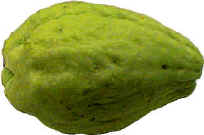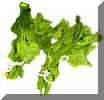|
|
|||
A pre-Columbian Central American food plant of the pumpkin family with a squash style texture, the chayote is used in many southern and south western dishes. Relished by the Mayans and Aztecs, chayote seeds have been found in diggings that date back eight thousand years. As most members of the squash family it is easily grown and produces abundant crops in many types of soil and fruits almost year-round. The pear shaped fruit is about 4 inches long with cream colored flesh and a single large seed. The chayote vine leaves are also edible , as is the fleshy root. The chayote comes in three varieties or variations; creamy white, pale green, and one that has spines protruding from the skin. all three varieties have a mild taste and the same relative shape. The squash's leaves are also cooked or served in a salad. The chayote contains an enzyme that if eaten in large amounts will cause the skin on the hand to peel much like an old sunburn. Chayotes can be scooped out stuffed and baked, julienne or thinly sliced as a garnish for soup salad or vegetable side dish. Chayotes may be eaten raw but it is preferable to quickly blanch to brighten them and soften their flavor. Select Should be free of indentations made by external forces such as birds or tools. They should be firm to the touch and not look shriveled in anyway. |


